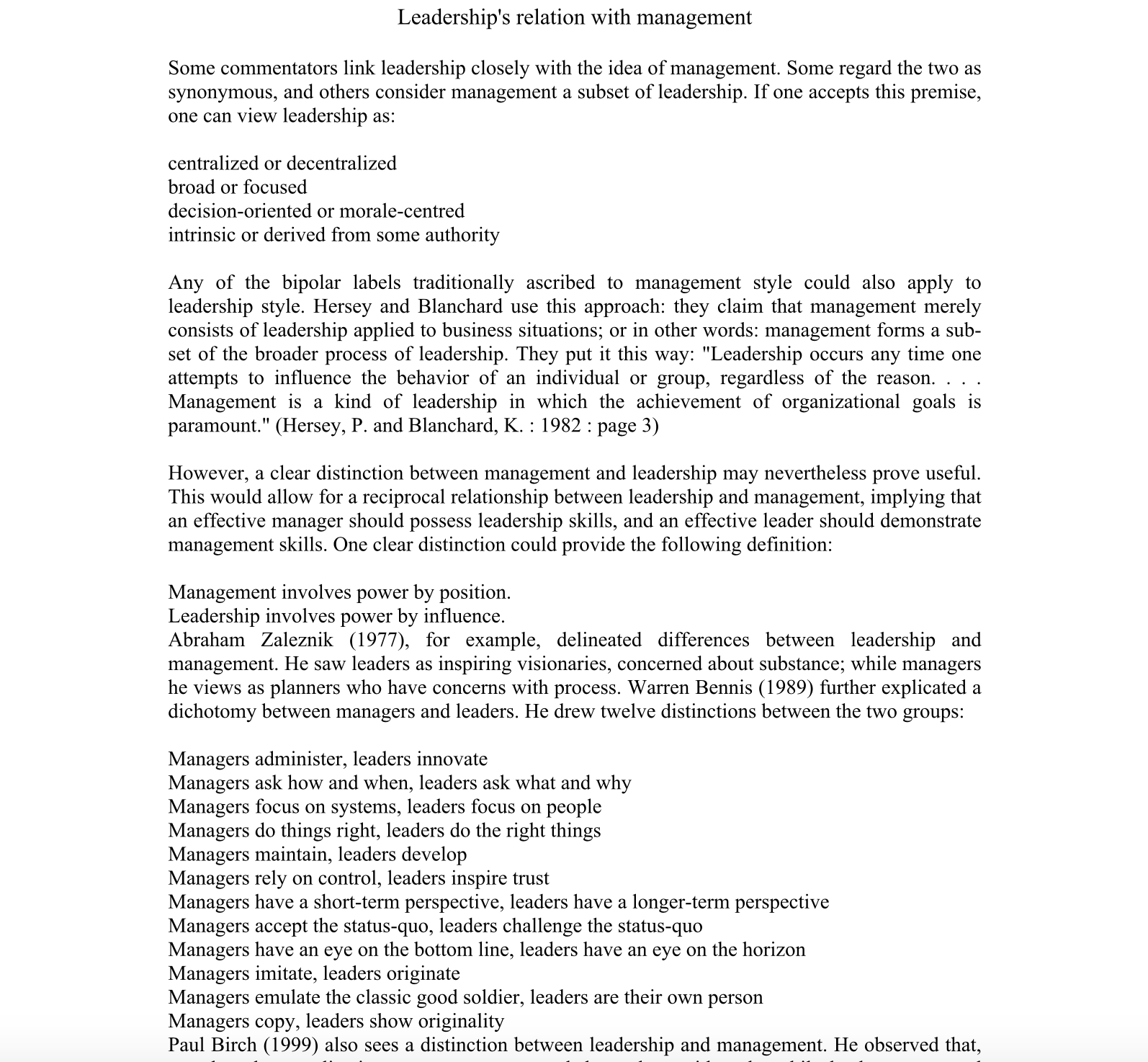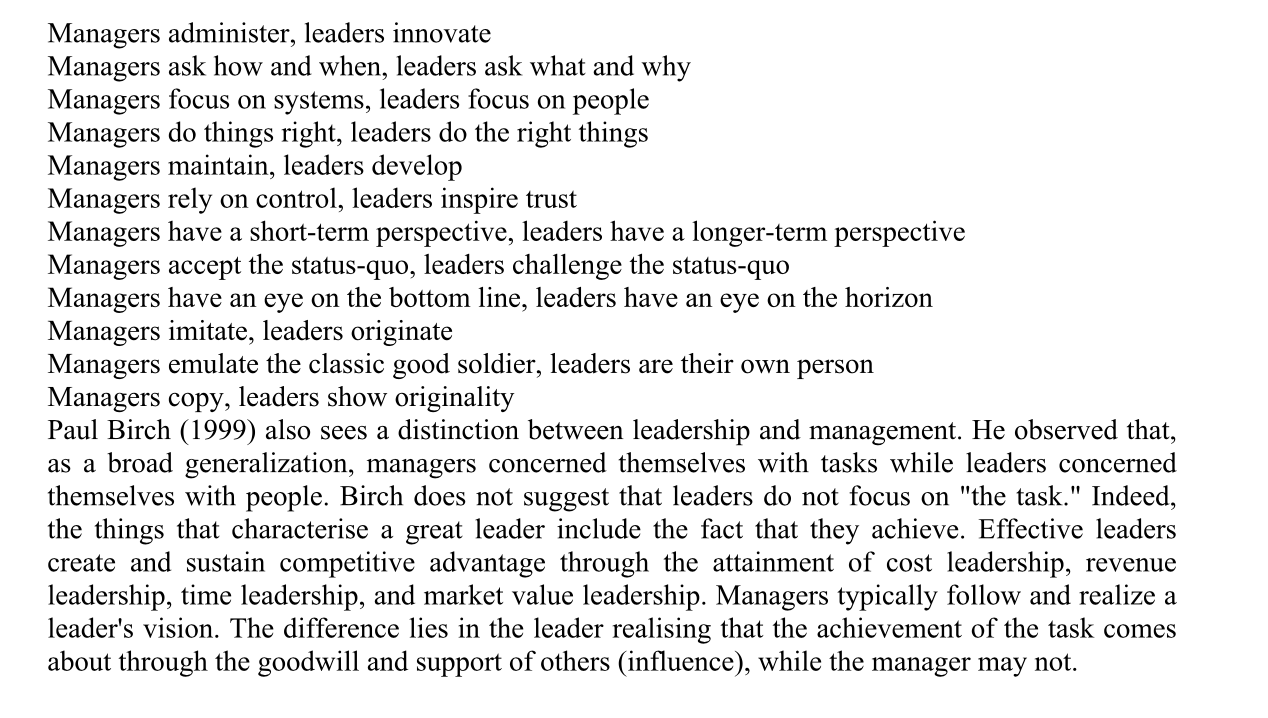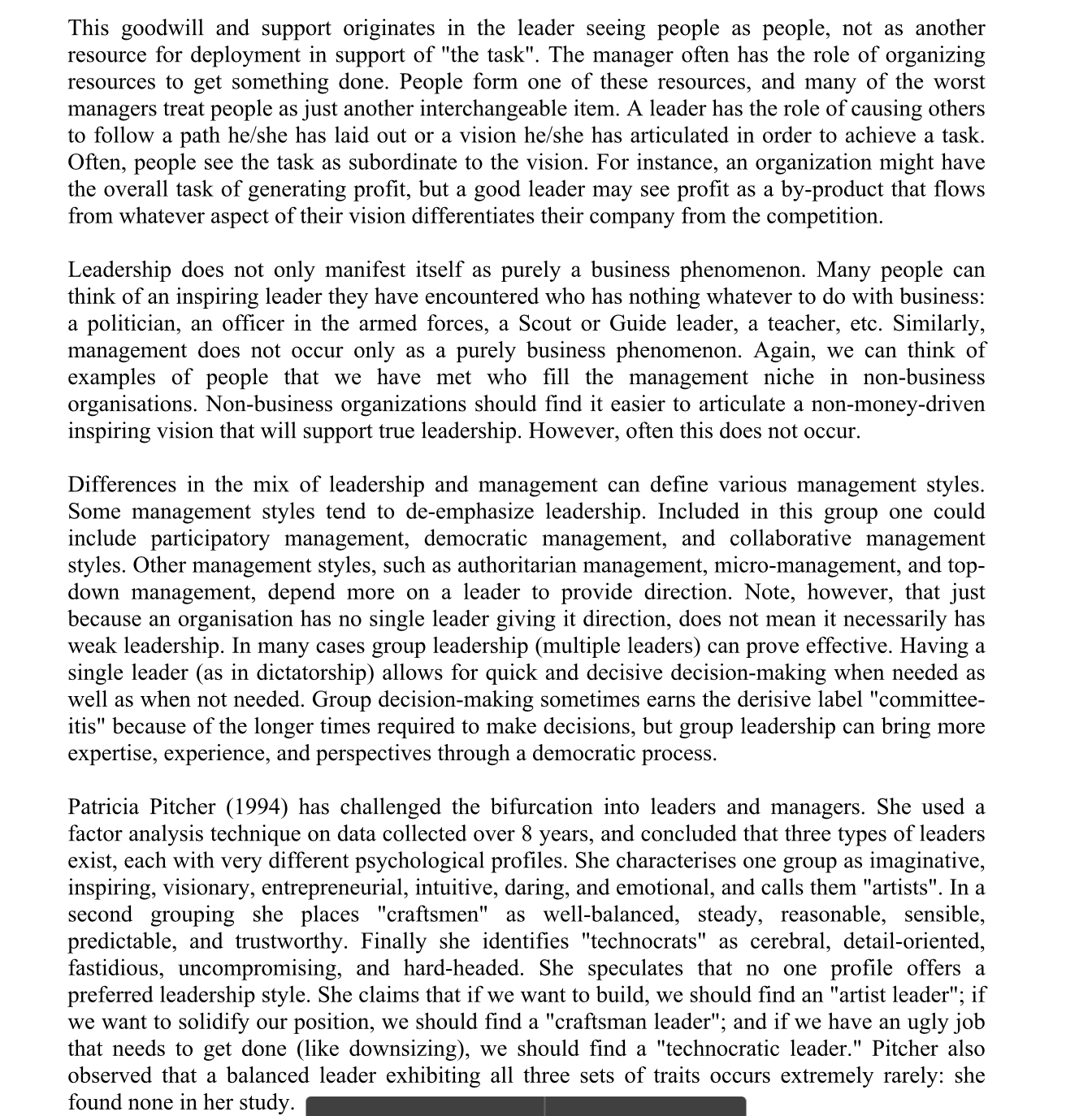The assignment is in the form of a short essay.
Focus on Definition, Explanation, Description and Discussion of how you see as a Manager or Leader in a contemporary changing business environment.(HAVING TO GIVE CLEARLY EXAMPLE FOR THIS CASE)
Leadership's relation with management Some commentators link leadership closely with the idea of management. Some regard the two as s3monymous, and others consider management a subset of leadership. If one accepts this premise, one can view leadership as: centralized or decentralized broad or focused decision-oriented or morale-centred intrinsic or derived from some authority Any of the bipolar labels traditionally ascribed to management style could also apply to leadership style. Hersey and Blanchard use this approach: they claim that management merely consists of leadership applied to business situations; or in other words: management forms a sub- set of the broader process of leadership. They put it this way: "Leadership occurs any time one attempts to inuence the behavior of an individual or group, regardless of the reason. . . . Management is a kind of leadership in which the achievement of organizational goals is paramount." (Hersey, P. and Blanchard, K. : 1982 : page 3) However, a clear distinction between management and leadership may nevertheless prove useil. This would allow for a reciprocal relationship between leadership and management, implying that an effective manager should possess leadership skills, and an effective leader should demonstrate management skills. One clear distinction could provide the following definition: Management involves power by position. Leadership involves power by inuence. Abraham Zaleznik (1977), for example, delineated differences between leadership and management. He saw leaders as inspiring visionaries, concerned about substance; while managers he views as planners who have concerns with process. Warren Bennis (1989) further explicated a dichotomy between managers and leaders. He drew twelve distinctions between the two groups: Managers administer, leaders innovate Managers ask how and when, leaders ask what and why Managers focus on systems, leaders focus on people Managers do things right, leaders do the right things Managers maintain, leaders develop Managers rely on control, leaders inspire trust Managers have a short-term perspective, leaders have a longer-term perspective Managers accept the status-quo, leaders challenge the status-quo Managers have an eye on the bottom line, leaders have an eye on the horizon Managers imitate, leaders originate Managers emulate the classic good soldier, leaders are their own person Managers copy, leaders show originality Paul Birch (1999) also sees a distinction between leadership and management. He observed that, Managers administer, leaders innovate Managers ask how and when, leaders ask what and why Managers focus on systems, leaders focus on people Managers do things right, leaders do the right things Managers maintain, leaders develop Managers rely on control, leaders inspire trust Managers have a short-term perspective, leaders have a longer-term perspective Managers accept the status-quo, leaders challenge the status-quo Managers have an eye on the bottom line, leaders have an eye on the horizon Managers imitate, leaders originate Managers emulate the classic good soldier, leaders are their own person Managers copy, leaders show originality Paul Birch (1999) also sees a distinction between leadership and management. He observed that, as a broad generalization, managers concerned themselves with tasks while leaders concerned themselves with people. Birch does not suggest that leaders do not focus on "the task." Indeed, the things that characterise a great leader include the fact that they achieve. Effective leaders create and sustain competitive advantage through the attainment of cost leadership, revenue leadership, time leadership, and market value leadership. Managers typically follow and realize a leader's vision. The difference lies in the leader realising that the achievement of the task comes about through the goodwill and support of others (inuence), while the manager may not. This goodwill and support originates in the leader seeing people as people, not as another resource for deployment in support of "the task". The manager often has the role of organizing resources to get something done. People form one of these resources, and many of the worst managers treat people as just another interchangeable item. A leader has the role of causing others to follow a path he/she has laid out or a vision he/she has articulated in order to achieve a task. Often, people see the task as subordinate to the vision. For instance, an organization might have the overall task of generating prot, but a good leader may see prot as a byproduct that ows from whatever aspect of their vision differentiates their company from the competition. Leadership does not only manifest itself as purely a business phenomenon. Many people can think of an inspiring leader they have encountered who has nothing whatever to do with business: a politician, an ofcer in the armed forces, a Scout or Guide leader, a teacher, etc. Similarly, management does not occur only as a purely business phenomenon. Again, we can think of examples of people that we have met who ll the management niche in non-business organisations. Non-business organizations should nd it easier to articulate a non-moneydriven inspiring vision that will support true leadership. However, often this does not occur. Differences in the mix of leadership and management can dene various management styles. Some management styles tend to deemphasize leadership. Included in this group one could include participatory management, democratic management, and collaborative management styles. Other management styles, such as authoritarian management, micromanagement, and top down management, depend more on a leader to provide direction. Note, however, that just because an organisation has no single leader giving it direction, does not mean it necessarily has weak leadership. In many cases group leadership (multiple leaders) can prove effective. Having a single leader (as in dictatorship) allows for quick and decisive decision-making when needed as well as when not needed. Group decision-making sometimes earns the derisive label "committee- itis" because of the longer times required to make decisions, but group leadership can bring more expertise, experience, and perspectives through a democratic process. Patricia Pitcher (1994) has challenged the bifurcation into leaders and managers. She used a factor analysis technique on data collected over 8 years, and concluded that three types of leaders exist, each with very different psychological proles. She characterises one group as imaginative, inspiring, visionary, entrepreneurial, intuitive, daring, and emotional, and calls them "artists". In a second grouping she places "craftsmen" as wellbalanced, steady, reasonable, sensible, predictable, and trustworthy. Finally she identies "technocrats" as cerebral, detail-oriented, fastidious, uncompromising, and hard-headed. She speculates that no one prole offers a preferred leadership style. She claims that if we want to build, we should nd an "artist leader"; if we want to solidify our position, we should nd a "craftsman leader"; and if we have an ugly job that needs to get done (like downsizing), we should nd a "technocratic leader." Pitcher also observed that a balanced leader exhibiting all three sets of traits occurs extremely rarely: she found none in her study.









